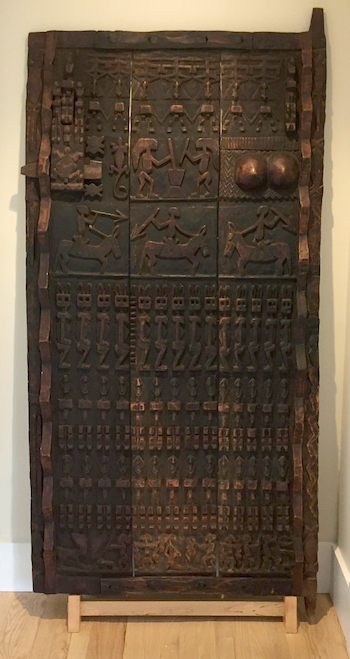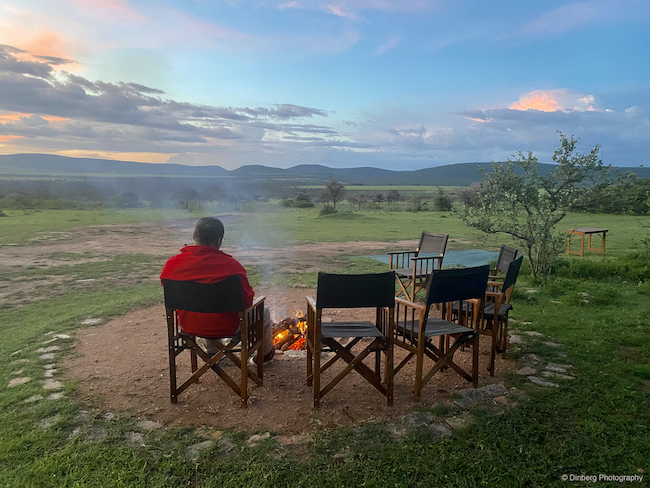Brattleboro penthouse reflects a couple’s love of African and Cuban cultures

Curtiss Reed, Jr. and Cathryn Griffith on the balcony of their downtown Brattleboro apartment, overlooking the Connecticut River and Mt. Wantastiquet.
By Joyce Marcel
Couples love to tell the story of how they met, but Curtiss Reed, Jr. and Cathryn Griffith have a love story that has three origins, not just one.
The first was in Aix-en-Provence, France, in 1986, when the two attended the same degree program at the same time — but somehow never met.
“I was a widow with a 12-year-old daughter,” Griffith said, laughing at the memory. “He said he would not have been interested in me.”
After not meeting in Aix, these sophisticated and well-travelled people moved on with their interesting and independent lives. Griffith, who is white, began a successful career as a commercial real estate developer in Boston. She also became an art photographer who, in 2010, had her photographs of Cuban architecture — matched with her collection of antique postcards of the same buildings — turned into a lovely coffee table book. And the aforementioned daughter, now grown, has made Griffith a grandmother three times over.
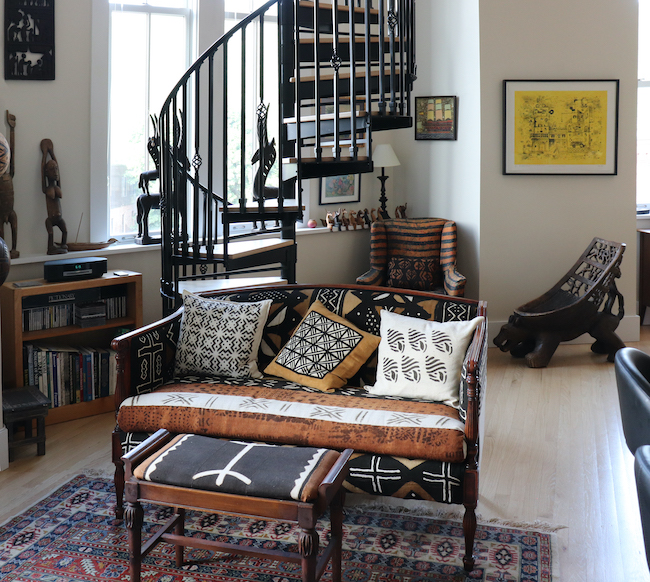
Interior view of the apartment, including spiral stairs to the tower room. The love seat features Bogolan cloth from Mali and pillowcases from Ghana and Mali. The yellow painting is by Cuban artist Luis Rodríguez Noa, who personalized it by labeling “Curtiss” in the picture.
Reed, who is Black, is the divorced father of three children, who are all in their 20s. He spent 18 years in Africa, beginning as a Peace Corps volunteer in Tunisia in March of 1983. There he fell in love with life overseas and made a career of it, working for the National Cooperative Business Association training cooperative management trainers in French0-speaking and Portuguese-speaking Africa. Then he spent four years doing the same with Africare.
“Cooperatives are a stealth way of introducing democracy to the developing world,” Reed said. “One person, one vote. Accountability. Service to your members. All the things co-ops stand for are really mini-democracies.”
Reed first discovered Vermont in December, 1978 when he came to ski; he liked it and relocated to Brattleboro in the spring of 1979. When he returned from Africa, he settled permanently in Brattleboro in April of 2001.
Reed is currently the executive director of Vermont Partnership for Fairness and Diversity. He provides expert training and coaching on racial issues to governmental agencies, municipal, institutional and business clients and community organizations across Vermont. He serves as chair of the Vermont Advisory Committee to the United States Commission on Civil Rights and sits on statewide commissions dealing with law enforcement, education, and minority health issues.
He is also the driving force behind four statewide initiatives: the Vermont African American Heritage Trail, the Vermont Vision for a Multicultural Future Initiative, I Am A Vermonter, and the Think Tank for Vermont Leaders of Color.
But we’re talking about love here. The second origin story begins with Reed and Griffith safely home, but lonely enough to turn to a dating app.
We were both online,” Reed said. “I saw her photo and just wrote her a note, a kind of ‘Shallow Hal’ kind of thing, like, ‘If we lived any closer I would be in hot pursuit.’ I had no expectation that I would ever hear from her again. I wanted to acknowledge that she’s a beautiful woman and I liked her profile, but I was looking for someone in my own back yard.”
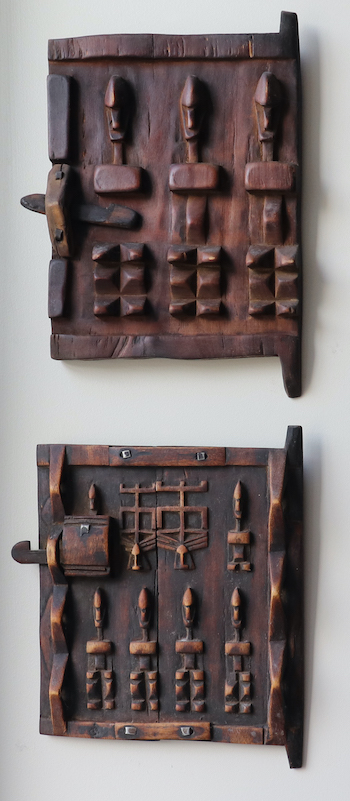 It was the kind of a web site where people use pseudonyms.
It was the kind of a web site where people use pseudonyms.
“You were Africa Nexus and I was Back Bay Artist,” Griffith said. “Did we write? I think we did.”
More time passed. Then friends invited Griffith to visit them at Stratton Mountain. While mapping out her route, Griffith realized she would be going through Brattleboro.
“I said, Oh, I wonder if it would be forward to contact that man?’” she said. “I had a picture of him in his Spandex bicycle outfit and one of him in an academic robe. And he had six passports, so I thought at least we’d have something to talk about.”
“So we met and started talking and the rest is history,” Reed said.
“I said, ‘You identified geography as an obstacle, but I have a car and I can drive, and I’d love to talk another time,’” Griffith said.
“I was hooked,” Reed said.
The couple was married on May 18, 2019, and spent their honeymoon on a transcontinental train trip from Boston to Vancouver in June of the same year. Later that year, they found their third origin story on a trip to Tanzania and Zanzibar.
“The first day, we went into a lodge organized by the tour company, and they said we’re going to meet a storyteller,” Griffith said. “This woman came and told us something about a fox and a muskrat, a moral story for children. Then she turned to me and said, ‘Are you married?’ And I said, ‘Yes, this is my husband.’ She said, ‘Oh no. He’s Maasai.’ I said, ‘Actually, he’s from America.’ And she said, ‘No! No! No! You came here to find a Maasai man and that’s the man you found. You came here looking for him.’”
And that settled that.
Griffith’s business holdings keep her busy in Boston; Reed’s work keeps him in Vermont. They’ve been spending much of the quarantine apart. But when they are together in Brattleboro, the two share a stunning and historic apartment in the renovated Brooks House on Main Street. The apartment, called the “penthouse,” is centered around an iron circular staircase that leads to the inside of the 1871 building’s Mansard roof. There’s a room up there where Rudyard Kipling and his cronies once played cards. Legend has it that the card players kept one of stairs squeaky so they could tell if the sheriff was coming.

Curtiss collects hand-carved masks in Africa. These masks (from left to right, with tribe names) are from: Ivory Coast, Tanzania (Makondé), Burkina Faso (Bwa), Ivory Coast (Baule), Ivory Coast, Burkina Faso (Bwa), and Ivory Coast
The apartment is filled with art and antiques which Reed collected during the time he lived in Africa. A stunning large red-figured Berber rug from North African fills the wall of one room — Reed said he found it in Tunisia. It hangs on a metal rod forged by an African blacksmith.
Beautiful masks, drums, and other musical instruments, including a collection of blacksmith-forged bells, are scattered about the rooms. Both the couch and the bed are covered in a dynamic yellow-and-black printed bògòlanfini fabric — the whole is made up of small strips hand-sewn together. There is a collection of interesting snuffboxes and another of handmade silver napkin rings.
The strongest pieces in the collection are carved wooden granary doors. These fascinating carvings, intended to protect the harvest, show in detail African village life — hunters, farmers, blacksmiths, healers, herders, women pounding grain and fertility images as well as crocodiles, cattle and horses. On one, some people are definitely making love. The largest door covers an entire wall and weighs over 300 pounds.
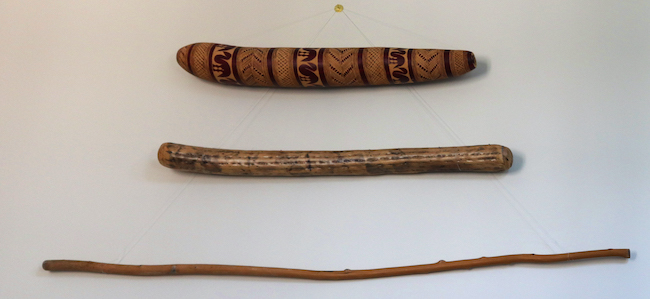
Top: musical instrument from Mali; middle: musical instrument from Ghana; bottom: Maasai walking stick, a gift to Curtiss from a Maasai warrior when Cathryn and Curtiss visited a Maasai village in December, 2019
“It took three strapping men to get it in here,” Reed said.
Griffith’s photographs, many from Africa and Cuba, also, decorate the walls. When she’s not dealing with industrial real estate, she continues with her photography.
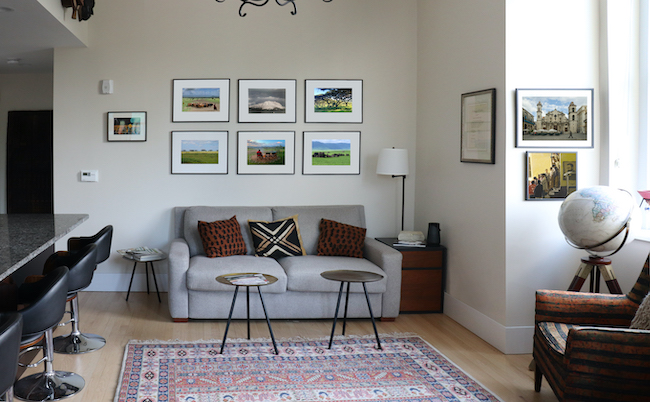
A view of the living room showing photographs by Cathryn, including pictures from trips to Provence, Tanzania and Cuba.
“I had a brownie camera as a kid, but I didn’t take it too seriously,” she said. “One of my brothers actually had chemicals, and we helped him process film. But I didn’t seriously start photographing until I studied in Aix. I had a camera with me and just began by photographing everything. I love open markets, and my family was florists, so I especially liked the flower market. Walking there in the mornings and seeing how florists were selling their gorgeous flowers outdoors expanded my sense of how florists could function. Then I began collecting old picture postcards of markets. That was the real beginning.”
When she returned to Boston, she began taking classes in photography. One of them led her and her camera to Cuba.
“In Havana there are many, many beautiful buildings built in Spanish Colonial times, in particular, but also, during the early years, after what we call the Spanish-American War,” Griffith said. “Many of those buildings have been adapted for new use. So I began photographing the buildings.”
Then, in Paris, she visited a market and found a cache of old picture postcards from Havana. She snapped them up and returned to Cuba. She was especially interested in taking photos that matched the ones on the old postcards. Her teachers told her she had found a book project. Eventually, they were proven right.
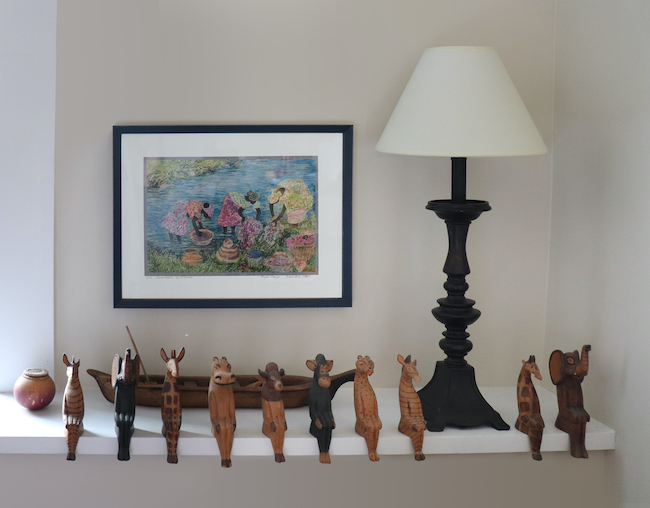
This painting shows women washing dishes and doing laundry in the Niger River in Mali. The hand-carved boat is from Guinea-Bissau, and the animals are from Ghana.
Before Covid-19, Griffith and Reed were working on one of Reed’s digital projects, I Am A Vermonter, which showcases the many people of color who have made their lives in Vermont, well-known as one of the whitest states in the union.
“The thrust of it is that if you were a person of color living elsewhere in the country, you might say, ‘Well, isn’t Vermont a really white state? How would I fit there? How would my family fit there? What would my kids do? What would my spouse do?’” Griffith said. “So I said to Curtiss, ‘We really have to show these people in their leisure activities. Show that they’re integrated in the community.’”
Now Griffith is shooting portraits to accompany the stories.
Reed, as it turns out, is a born collector. He still has a collection of childhood memorabilia that includes a piece of bleached driftwood and shells as well as some snakeskins.
“Those are some of the mementos from the best years of my life,” Reed said. “The second best years of my life were in Africa. And now the third best years of my life are with Cathryn. For me, a collector is someone who cherishes memories. And these are objects that manifest those memories.”
Join Curtiss and Cathryn in a virtual conversation about their collecting:
Presented by the Wellesley College Friends of Art
Thursday, February 11, 2021 at 5 PM EST — FREE
Register here to receive the Zoom link
For the Love of Collecting: A Conversation on Collecting with Cathryn Griffith DS ’88, Curtiss Reed Jr. and Amanda Gilvin, Senior Curator of Collections and Assistant Director of Curatorial Affairs at the Davis Museum.
Amanda Gilvin’s extensive experience working directly with art collectors and private collections has attracted unique personal collections to the Davis Museum in recent years, such as the African art and artifacts collection from Susanne Klejman Bennet, class of 1959. In addition her groundbreaking exhibition and symposium on Fatimah Tuggar at the Davis Museum was based on her specialized research and scholarship on African Art and Artifacts from the Diaspora. The Boston Chapter of the Wellesley Friends of Art, is pleased to announce that Amanda will moderate a conversation between Cathryn Griffith, CEDS’88 and her partner, Curtiss Reed, Jr. to inaugurate our 2020-2021 season on virtual events.
Cathryn Griffith’s extensive research and scholarship in Cuba resulted in her book, Havana Revisited: An Architectural Heritage, featuring her original photographs juxtaposed with 100-year-old colored postcards, and a 30-minute video “La Habana 500” produced in celebration of the 500th anniversary of the founding of Havana. Her passion for Cuba also led her to meet and visit with many artists, whose work she has collected during the nearly 20 years she has traveled to and worked in Cuba.
Her partner, Curtiss Reed, Jr., worked and traveled across the African continent, including Mali and Niger, for over 20 years with the Peace Corps and other international development organizations. Along the way he collected many African masks, textiles and works of art. Their individual stories of collecting art coupled with their parallel passions for research, scholarship and international diplomacy will make a fascinating conversation that Amanda Gilvin is uniquely qualified to moderate. We hope you will join us for this event.


